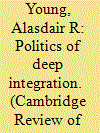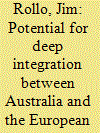| Srl | Item |
| 1 |
ID:
159604


|
|
|
|
|
| Summary/Abstract |
Twenty-five years ago, as preferential trade agreements started to proliferate, Jagdish Bhagwati sounded the ‘spaghetti bowl’ alarm, arguing that the ensuing complexity would create inefficiencies in the international system and challenges for firms navigating overlapping rules. This article seeks to update and complement Bhagwati’s thesis by asking if proliferating ‘deep’ trade agreements add a new dimension of complexity to this picture. This article shows that the early answer to this question is ‘not yet’, as governments have discovered that prospective conflicts with existing or simultaneous commitments limit just how deep the provisions of an agreement can be. Governments managing multiple deep agreements play a variation on Putnam’s two-level game. As Putnam theorized, these governments reconcile domestic interests with international opportunities in formulating their strategies. However, ensuring compatibility across various, sometimes competing international opportunities is also a key consideration. Canada’s concurrent participation in the Trans-Pacific Partnership (TPP) and the Canada–European Union Comprehensive Economic and Trade Agreement (CETA) provides a crucial exploratory case study.
|
|
|
|
|
|
|
|
|
|
|
|
|
|
|
|
| 2 |
ID:
159599


|
|
|
|
|
| Summary/Abstract |
Efforts to pursue ‘deep integration’—agreeing to international rules governing domestic policies to mitigate their adverse trade effects—have been pivotal to the politicization of trade policy. The contributions to this special issue focus on different political dynamics associated with recent high-profile efforts at deep integration. Collectively, they analyse the Transatlantic Trade and Investment Partnership (TTIP), the Comprehensive Economic and Trade Agreement (CETA), the Transpacific Partnership (TPP) and the Japan–European Union Economic Partnership Agreement (JEEPA) negotiations. The special issue, therefore, focuses on extreme examples of deep integration in order to illuminate new political dynamics. This introductory article introduces the concept of ‘deep integration’ and explores how it has been pursued in historical and contemporary trade negotiations. It also relates recent attempts at deep integration to the rise of populist anti-globalization movements. In light of these discussions, this article introduces the contributions to the issue. It concludes by considering whether the politics associated with TTIP and CETA in Europe represent the future of trade policy.
|
|
|
|
|
|
|
|
|
|
|
|
|
|
|
|
| 3 |
ID:
105896


|
|
|
|
|
| Publication |
2011.
|
| Summary/Abstract |
This paper aims to identify evidence of any potential costs of preferential liberalisation of trade in goods between the EU and Australia, notably trade diversion; move beyond Australia's exports of commodities to the EU to look for evidence of competitiveness in high-value-added manufactures; and identify evidence of the potential for deep integration that might be promoted by a formal FTA using the Sussex Framework for analysing economic integration and TradeSift software. It concludes that costs of trade Diversion are unlikely to be large; that there is the potential for a mutual recognition agreement to encourage deep integration in areas of high value added manufactures; but that it might require a formal free trade agreement to give the institutional framework to allow mutual recognition to work.
|
|
|
|
|
|
|
|
|
|
|
|
|
|
|
|